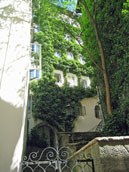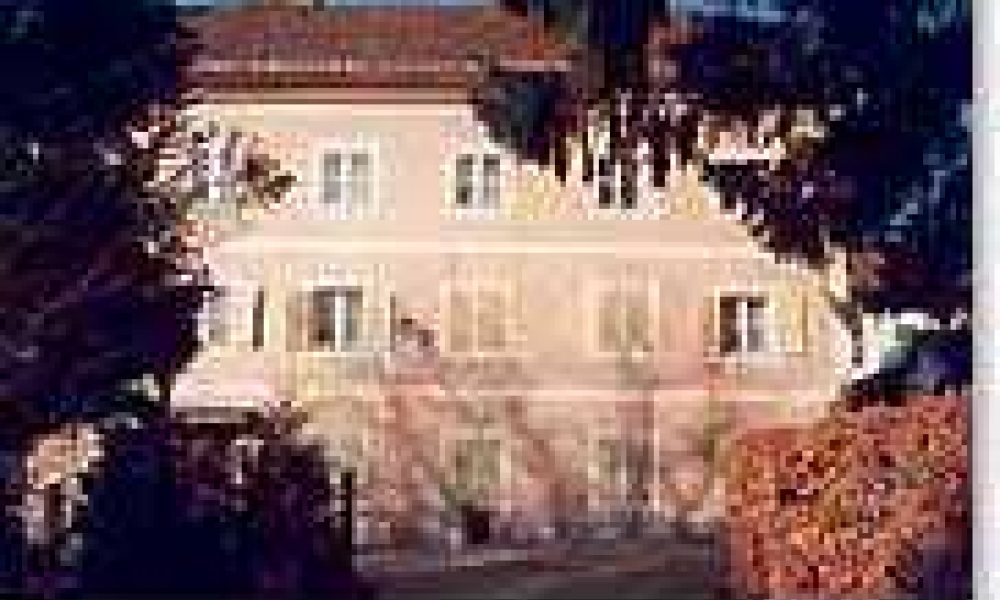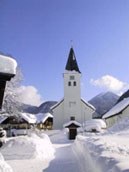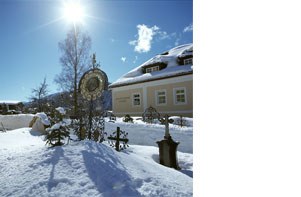Joseph Mohr
City of Salzburg - childhood and youth
Josephus Franciscus Mohr was born in the city of Salzburg on the 11th of December, 1792, the son of an unmarried embroiderer, Anna Schoiberin, and a mercenary soldier, Franz Mohr (Moor) who deserted the army and Joseph's mother before the birth. The ancestors on his father's side came from the town of Mariapfarr in the mountainous Lungau region south of Salzburg, while his mother's family was from the salt-mining city of Hallein. At the baptism shortly after birth, the godfather was recorded as Joseph Wohlmuth, the last official executioner of Salzburg, who did not personally attend but had himself represented by one Franziska Zachin. As the parents were unmarried, Joseph received the name of his father, according to custom. His mother had a total of four illegitimate children. In 1794, at the age of 2, Mohr lived on the third floor of the house located at Steingasse Nr. 31 in Salzburg across the river from the Old Town. Until recently, it had been supposed that he lived at Steingasse Nr. 9 (see footnote).
Poverty marked the early life of Joseph Mohr until the priest, Johann Nepomuk Hiernle, took him under his wing. Hiernle served as a vicar and leader of music at the Salzburg Cathedral. He enabled the talented Mohr to have an education and encouraged him in music. As a young boy, Mohr would serve simultaneously as a singer and violinist in the choirs of the University Church and at the Benedictine monastery church of St. Peter. From 1808 to 1810, Mohr studied at the Benedictine monastery of Kremsmünster in the province of Upper Austria. He then returned to Salzburg to attend the Lyceum school, and in 1811, he entered the seminary. Since he was of illegitimate birth, a special dispensation had to be obtained for him to attend seminary. On the 21st of August, 1815, Mohr graduated and was ordained as a priest.
Footnote
Research carried out in 1999 shed new light on the location of Mohr's childhood home. For many years it was assumed that he lived at Steingasse Nr. 9. It is now confirmed that the correct address was Steingasse Nr. 31. The error can be attributed to confusion regarding the placement of the "Noestler House" in which Mohr is recorded to have lived at the time of the 1794 Census. The "Noestler House in the Stone Quarter" ("Noestler Haus in Stain Viertel") was confirmed as Nr. 31 through the name of its owner, Joseph Gruntner (Maurer) which is also recorded in the 1794 Census. The house at Steingasse Nr. 9 was recorded then as the "Hutterer House in Stone in the Lower Bridge Quarter" ("Hutterer Haus in Stein im Unterbruckviertel"). Visitors to Salzburg will still find a plaque on the wall outside Nr. 9 honoring Joseph Mohr and "Silent Night!".
Life as a priest - a journey of many moves
In the fall of 1815, Mohr's first official assignment as a priest was set to be in Mariapfarr in the Lungau region of the Province of Salzburg. But before he could set off to this town which also was the location of his father's family, he was asked to provide temporary help in the village of Ramsau near Berchtesgaden. Mohr did then serve as assistant priest in Mariapfarr (1815-1817). It was during this time, in 1816, that he penned the words to "Silent Night!" in Mariapfarr. Poor health forced him to return to Salzburg in the summer of 1817, and then after a short recuperation he began serving as an assistant priest in Oberndorf that same year. Mohr moved frequently in his career as priest, something not uncommon in those days. He would spend just 2 years in Oberndorf, followed by Kuchl (1819-1820), Golling (1820-1821), Vigaun (1821-1822, serving also in Adnet and Koppl), Anthering (1822-1824, serving also in Koppl), Eugendorf (1824-1827), Hof (1827), Hintersee (1827-1837), and finally Wagrain (1837-1848).
Oberndorf - from "songs which do not edify" to "Silent Night!"
Starting in August 1817, Mohr was asked to provide temporary assistance to the Oberndorf parish priest Josef Kessler. In October, he was officially named to the open position of assistant priest (Koadjutor). Around this same time, his supervisor was replaced with the parish priest Georg Heinrich Nöstler. As the village of Oberndorf possessed no proper vicarage for its priests, Mohr would sleep in the church caretaker's house, while taking his meals generally in nearby "Gasthof" restaurants. Financial problems in the parish contributed to making the relationship between Mohr and Nöstler tense. Moreover, Nöstler was critical of his young assistant priest, accusing him of "neglecting his priestly duties, frequenting drinking locales, joking with persons of the opposite sex, and singing songs which do not edify." The deacon of nearby St. Georgen, who served as overseer of the Oberndorfer priests, along with the town leaders in Oberndorf, responded in writing saying these accusations were unfounded.
The paths of Mohr and Gruber crossed in Oberndorf. Together they created "Silent Night! Holy Night!" performing it for the first time at Christmas, 1818. By September, 1819, Mohr was on his way again, moving this time to Kuchl.
Hintersee - first full responsibility for a parish
1827 kam Mohr nach Hintersee, das im folgenden Jahr zu einem Vikariat aufgewertet wurde. Diese Pfarre war die erste, die er selbständig verwalten konnte. Als er die Pfarre übernahm, hatte er 272 Katholiken zu betreuen, in seinem letzten Jahr waren es 293. Während seiner Tätigkeit bescheinigte man ihm Leutseligkeit, Friedensliebe und Popularität. Trotz dieser positiven Bewertungen leitete man 1834 gegen Mohr eine Untersuchung wegen nachlässiger Erfüllung der Berufspflichten ein. Die Anschuldigungen erwiesen sich als nicht gerechtfertigt und Mohr wurde rehabilitiert.
Wagrain - making impact as a social reformer
After Hintersee, Mohr moved to Wagrain in 1837. There his impact with the parish was considerable and lasting, inspiring villagers to refer to him as a social reformer. The construction of a school building was due largely to his initiative. Already in the winter of 1837/38, shortly after his arrival, the villagers began gathering building materials. The two-story building went up remarkably fast with the official opening celebrated in November, 1838. Mohr also gave his attention to the poor and needy. He worked to modify and then administer with great care a program which provided room and board for the poor and aged by placing them at local farmhouses. In 1843, Mohr applied for a position at the parish of Mauterndorf, but was not chosen. A letter of recommendation submitted in the process praised him for his outstanding pastoral work in Wagrain. On December 4, 1848, Joseph Mohr died of lung disease.




